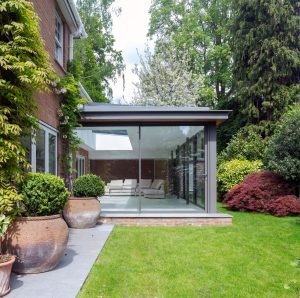Sliding into focus

As latest industry reports show that sliding doors are overtaking, or are neck-and-neck, with bi-folds, Mike Wilson, regional sales manager at Everglade Windows, explores what the shift tells us about market trends.
The latest WindowBase Window & Door Market Trends 2025 report confirms a key development for the trade: sliding doors are growing in market share and edging closer to bi-fold doors in popularity, with a current split according to the report of 52% to 48% in favour of bi-folds.
But this isn’t about one product replacing another – it’s about meeting different homeowner expectations with the right solutions.
The numbers show a turning point. While bi-fold doors have long been considered a premium product, the increasing demand for sliding doors, especially in aluminium, suggests a more practical trend emerging. Installers across the UK are seeing that sliding doors can offer larger uninterrupted views, improved thermal performance and simpler operation.
For homeowners, it’s a case of futureproofing: making design choices that look good now and continue to deliver value for years to come.
This trend comes as no surprise to us at Everglade Windows. Our next generation aïr 400SS minimal frame sliding door has seen a consistent rise in popularity, and we believe it’s because it aligns well with what homeowners want right now: sleek aesthetics, minimal sightlines and excellent energy efficiency.
And for installers, it’s a product that delivers ease of installation and fewer call-backs – critical advantages in a challenging economy.
Answering the call for more glass and cleaner lines, our aïr 400SS minimal frame sliding door now features slimmer interlock options of 34mm and 20mm (down from 50mm and 25mm), supporting even larger glazed areas with less visible frame.
Plus, it delivers on-site with practical benefits like site-bonded glazing for easier installation, and comes PAS24:2022 certified with U-values from 1.2 W/m²K. It’s the kind of system that helps installers meet technical demands without sacrificing style or adding complexity to the job.
So, what’s driving this shift in preference?
One explanation lies in wider market pressures. The UK housing market remains uncertain, and consumer behaviour is changing. According to the report, we’re seeing a “tale of two homeowners”: those with equity and disposable income are still spending, particularly on premium upgrades, while younger buyers and mortgage-heavy households are scaling back. For the former group, upgrading to a feature-rich sliding door is an appealing choice, especially when the return on investment is visible through improved kerb appeal and energy savings.
At the same time, price pressure is affecting the bi-fold segment. The average installed price per leaf has dropped to a record low in some regions (under £1,000) according to the report. That’s squeezing margins, particularly for installers in highly competitive areas.
Sliding doors, by contrast, haven’t seen the same price erosion. In many cases, they’re now viewed as a refined, space-efficient alternative – especially in urban homes where interior layout matters just as much as access to outdoor space.
Of course, we’re not seeing the end of bi-folds. Rather, we’re seeing a shift in how they’re specified. It’s a move away from basic models and towards well-engineered, high-performing systems with real design appeal. Homeowners aren’t walking away from the concept of bi-fold doors – they’re walking away from the bottom of the market.
That’s a crucial distinction for fabricators and installers alike.
Take our aïr 900 bifold door, a long-standing favourite for its ultra-slim 107mm sightlines and strong thermal performance. With the rise of steel-look glazing, we’ve expanded this offer with the aïr 900 Heritage bi-fold door, giving installers a solution that captures the industrial and art deco trend – relevant not just for heritage renovations, but for contemporary designs too.
It’s also worth noting that aluminium is gaining even more ground. The report shows that 87% of installers now sell aluminium products – up from 78% just a year ago. It’s a clear sign that aluminium has become the go-to for higher-end installations, thanks to its durability, colour flexibility and thermal capabilities.
The data is clear: the shift is happening. Now is the time for installers to position themselves with a product portfolio that’s in step with the next phase of consumer demand. Success in today’s market isn’t about choosing between sliding or bi-fold doors – it’s about offering the right versions of both.
Those who want to stay competitive need to reflect design trends, like heritage styling, while backing them up with robust technical performance.
